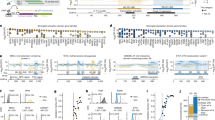Abstract
Two similarities among transcriptional activating regions of many eukaryotic transcription factors, like those from GAL4, GCN4, and VP16, are that they have a net negative charge, and that many of them can potentially form amphipathic α-helices with acidic amino acids on the hydrophilic face. Based on these similarities, E. Giniger and M. Ptashne previously designed a short peptide (AH) which is predicted to have the potential to form a negatively charged amphipathic α-helix; AH was able to mediate transcription activation in yeast when it was attached to the DNA binding and dimerization portion of GAL4 [GAL4(1-147)]. This paper describes screening of a pool of AH derivatives containing randomized amino acids fused to GAL4(1-147) and to an analogous region of LexA [LexA(1-87)] in yeast strains. Results suggest that both acidic and hydrophobic amino acids are critical features of activating regons — these results are consistent with the model that activating regions often form amphipathic α-helices. This work is novel because hydrophobic amino acids are also shown to be important in activating regions of yeast transciption factors.
Similar content being viewed by others
References
Brendel V, Karlin S (1989) Association of charge clusters with functional domains of cellular transcription factors. Proc Natl Acad Sci USA 86: 5698–5702
Brent R, Ptashne M (1985) A eukaryotic transcriptional activator bearing the DNA specificity of a prokaryotic repressor. Cell 43: 729–736
Bushman FD, Shang C, Ptashne M (1989) A single glutamic acid residue plays a key role in the transcriptional activation function of lambda repressor. Cell 58: 1163–1171
Carey M, Kakidani H, Leatherwood J, Mostashari F, Ptashne M (1990) An amino-terminal fragment of GAL4 binds DNA as a dimer. J Mol Biol 209: 423–432
Courey AJ, Tjian R (1988) Anaoysis of Sp1 in vivo reveals multiple transcriptional domains, including a novel glutamine-rich activation motif. Cell 55: 887–898
Cress WD, Triezenberg SJ (1991) Critical structural elements of the VP16 transcriptional activation domain. Science 251: 87–90
Driever W, Ma J, Nüsslein-Vohard C, Ptashne M (1989) Rescue of bicoid mutant Drosophila embryos by bicoid fusion proteins containing heterologous activating sequences. Nature 342: 149–154
Frankel AD, Kim PS (1991) Modular structure of transcription factors. Cell 65: 717–719
Gill G, Sadowski I, Ptashne M (1990) Mutations that increase the activity of a transcriptional activator in yeast and mammalian cells. Proc Natl Acad Sci USA 87: 2127–2131
Giniger E, Ptashne M (1987) Transcription in yeast activated by a putative amphipathic alpha helix linked to a DNA binding unit. Nature 330: 670–672
Himmelfarb HJ, Pearlberg J, Last D, Ptashne M (1991) GAL11P: a yeast mutation that potentiates the effect of weak GAL4-derived activators. Cell 63: 1299–1309
Hochschild A, Ptashne M (1988) Interaction at a distance between lambda repressors disrupts gene activation. Nature 336: 353–357
Hope IA, Struhl K (1986) Functional dissection of a eukaryotic transcriptional activator protein, GCN4 of yeast. Cell 46: 885–894
Hope IA, Mahadevan S, Struhl K (1988) Structural and functional characterization of the short acidic transcriptional activation region of yeast GCN4 protein. Nature 333: 635–640
Johnston M (1987) A model fungal gene regulatory circuit: the GAL genes of Saccharomyces cerevisiae. Microbiol Rev 51: 458–476
Lin Y-S, Green MR (1991) Mechanism of action of an acidic transcriptional activator in vitro. Cell 64: 971–981
Little LW, Mount DW (1982) The SOS regulatory system of Escherichia coli. Cell 29: 11–22
Ma J Ptashne M (1987a) Deletion analysis of GAL4 defines two transcriptional activating segments. Cell 48: 847–853
Ma J, Ptashne M (1987b) A new class of yeast transcriptional activators. Cell 51: 113–119
Mermod N, O'Neill EA, Kelly TJ, Tjian R (1988) The proline-rich transcriptional activator of CTF/NF-1 is distinct from the replication and DNA binding domain. Cell 58: 741–753
Mitchell PJ, Tjian R (1989) Transcription regulation in mammalian cells by sequence-specific DNA binding proteins. Science 245: 371–378
Ptashne M (1988) How eukaryotic transcriptional activators work. Nature 335: 683–689
Ptashne M, Gann AF (1990) Activators and targets. Nature 346: 329–331
Ruden DM, Ma J, Ptashne M (1988) No strict alignment is required between a transcriptional activator binding site and the “TATA box” of a yeast gene. Proc Natl Acad Sci USA 85: 4262–4266
Ruden DM, Ma J, Wood K, Li Y, Ptashne M (1991) Generating yeast transcriptional activators containing no yeast protein sequences. Nature 350: 250–252
Sherman F, Fink G, Lawrence C (1983), Methods in yeast genetics, revised. Cold Spring Harbor Laboratory Press, Cold Spring Harbor, NY
Sigler PB (1988) Acid blobs and negative noodles. Nature 333: 210–213
Stringer KF, Ingles CJ, Greenblatt J (1990) Direct and selective binding of an acidic transcriptional activator domain to the TATA-box factor TFIID. Nature 345: 783–786
Author information
Authors and Affiliations
Additional information
by H. Jäckle
Rights and permissions
About this article
Cite this article
Ruden, D.M. Activating regions of yeast transcription factors must have both acidic and hydrophobic amino acids. Chromosoma 101, 342–348 (1992). https://doi.org/10.1007/BF00346013
Received:
Accepted:
Issue Date:
DOI: https://doi.org/10.1007/BF00346013




